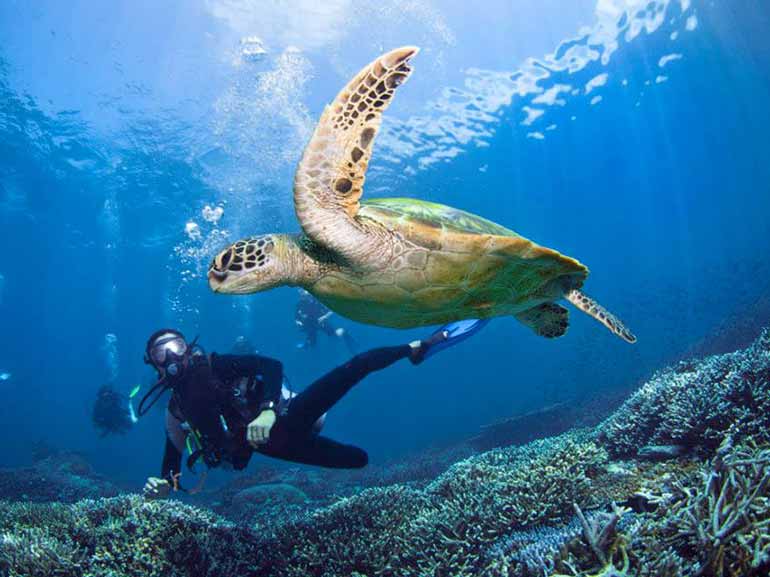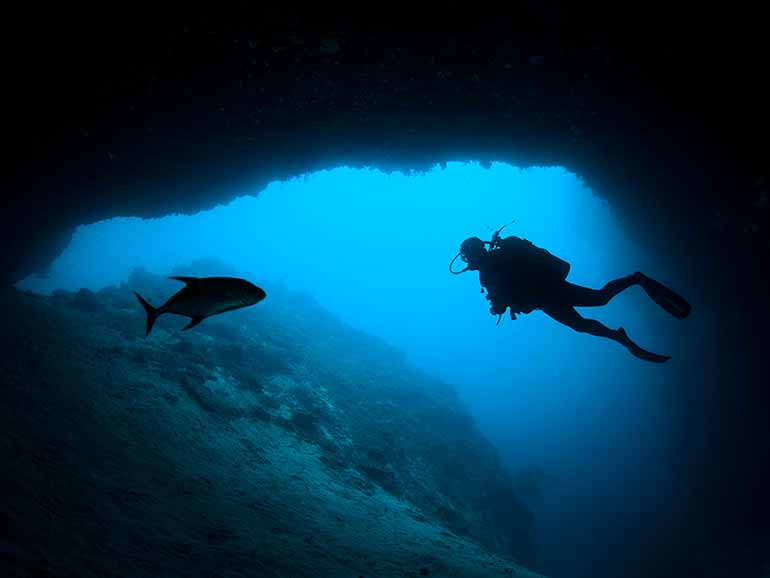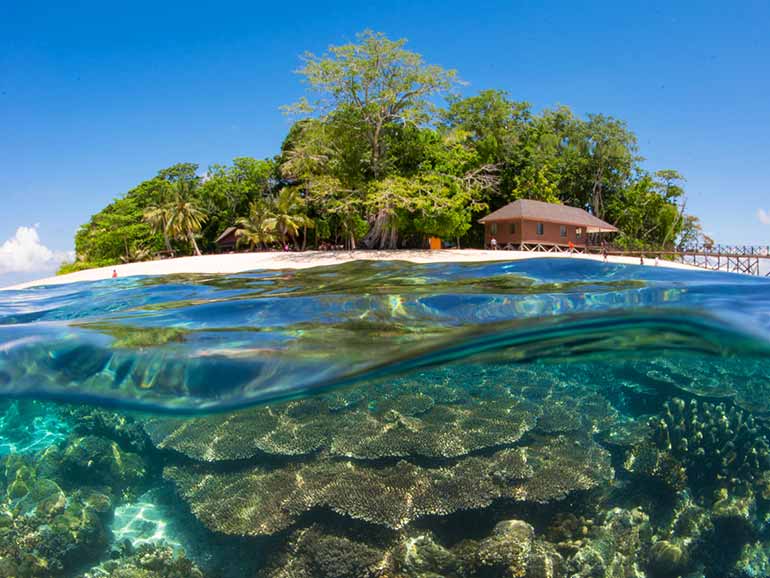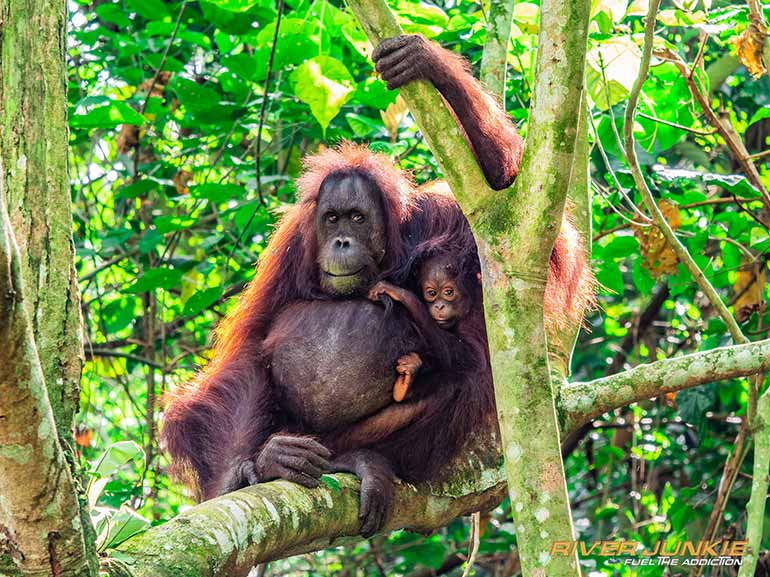
Sipadan Island is at the top of many divers bucket lists. Year after year it is voted one of the best diving spots in the whole world... In this blog post we are going to cover everything you’ll need to know about diving in Sipadan, so buckle up and enjoy the read!

If you’re a scuba diver reading this blog it’s likely that this is not the first time you’ve heard about Sipadan. Every year, the island frequents the list of the top 10 world’s best dive sites, and it’s not hard to see why! There are few places in the world that offers such rich biodiversity. Sharks, turtles, swirling barracuda tornadoes, enormous schools of trevally and bustling reefs full of reef fish are just a few of the highlights when diving at Sipadan.
Do you like sharks? White-tip and grey reef sharks, hammerheads, leopard sharks, threshers and even whale sharks are some of the species you may encounter diving here. It’s also a real turtle heaven, with both green turtles and the smaller hawksbills virtually guaranteed. It’s not uncommon to see more than 20 turtles in just one dive!
Do you want more? How about the famous barracuda tornado, the resident school of jackfish, or the rampaging herd of bumphead parrotfish? Still want more? There’s also a wealth of macro life - octopus, leaf scorpion fish, lobsters and nudibranchs are common finds here amongst many others. Of course these require you to peel your eyes off the blue and the big fish action going on around you!
There is simply no such thing as a bad day at Sipadan, and we truly believe that this is one of, if not THE best dive spot in the entire world!

Located in the Celebes Sea, Sipadan Island was formed as corals grew on top of an extinct volcano over thousands and thousands of years. Sipadan is the only volcanic island in Malaysia to breach the surface, and today the island drops straight to the sea floor over 2,000 meters deep!
Sipadan is located in the middle of the coral triangle, the richest marine habitat in the entire world. This area sports over 600 different coral species and nearly 3,000 fish species. It is safe to say that this is one of the most biodiverse marine areas on the entire planet, and you’ll probably need to bring some extra pages for your log book to note down all the different marine life you’ve seen on your dives!
The Island is a national park under the protection of Sabah Parks, and is a complete no-fishing zone. You will not find any fishermen here. From commercial ships to small one-man boats, fishing is not allowed within a 500m radius of Sipadan. As a result, you will see a staggering amount of fish life whilst diving here, indeed sometimes it can be hard to keep track of your dive buddies due to the sheer amount of fish!
The oceanic currents and the depth of the island makes Sipadan a converging point for pelagic marine life. The whole marine food chain in its entirety can be found here! The beauty of Sipadan lies in its diversity, from tiny nudibranchs and colourful reef fish to whales, sharks and turtles – it truly holds the spot as one of the most unique dive spots in the world!

Sipadan Island is located off the east coast of Borneo, in the Malaysian state of Sabah. Most people fly in to Tawau Airport, which has daily connections to Kuala Lumpur and Kota Kinabalu airports. From Tawau Airport it’s just over an hour drive to reach Semporna Town – which is the gateway to diving Sipadan and the surrounding islands.
If you’re travelling around Borneo on a budget you can also reach Semporna by bus from Kota Kinabalu, Sandakan or Tawau. Local buses are cheap and it’s fairly easy to buy tickets – something to consider, if you’ve got the time and don’t mind a bit of a bumpy ride.
If you are on a very tight budget you can choose to stay in Semporna whilst exploring the different islands, or you can use it as a short stop over on your way to Mabul Island – which is where most people choose to base themselves to explore Sipadan.
Mabul is about an hour boat journey away from Semporna, and it is where you’ll find most dive resorts! There are no resorts on Sipadan itself, and it is not possible to stay overnight on the island as it’s a national park.

Scuba Junkie Mabul Beach Resort offers the perfect base to explore Sipadan and its neighboring islands. The resort has many different room types to suit all different budgets. Backpackers on a shoe-string budget (or simply those who love to socialize and meet new people) can choose to stay in our comfortable dorm rooms. If you prefer a bit of privacy there are both private fan and AC en-suite rooms with great value for money, and for those seeking affordable luxury there are two VIP rooms with sea-view.
Accommodation at Mabul Beach Resort comes with full board – including breakfast, lunch, dinner and homemade snacks throughout the day with free refill of water, tea and coffee 24/7! The open plan restaurant and the two panoramic bars offers plenty of chance to meet new people and hang out with your dive buddies. For those seeking a quiet moment, you can hang out on the beach or in the hammock on your private balcony. With these all-inclusive packages you can worry less about the logistics, and focus more on relaxing and enjoying the incredible diving this area has to offer!
When you’re choosing where to stay, and whom to dive Sipadan with, make sure you do your research! A good place to start is to read honest customer reviews on TripAdvisor on the companies you are considering. Keep in mind things such as divers to dive guide ratios, safety procedures, standard of rental equipment and how long your dives will be (many operators do a maximum of 45 minutes per dive, even if you’ve still got air left). Cheaper does not always equal better, so make sure you ask the right questions before booking!

Sipadan is a marine protected area, and entry to the island is limited to 176 visitors per day. In order to visit the island you need a Sipadan permit acquired from Sabah Parks. The daily limit prevents excess stress on the reefs and the marine life, caused by too many divers and tourists.
With Sipadan being one of the best dive spots in the world, and there being limited available spaces each day it is important that you plan your trip early enough to secure a permit! For many divers, a holiday to Borneo is a once in a lifetime trip, and the last thing you would want is to finally turn up on site, only to find out there are no Sipadan permits available…
Here are our top tips for securing your golden ticket to diving Sipadan:
To make sure you get a hold of a Sipadan permit, the best tip we have is to book a package with a dive resort which guarantees your permit! At Scuba Junkie, Sipadan permits are allocated via all-inclusive Sipadan diving packages starting at 4 days/3nights. They include accommodation, full meals, equipment rental, 3 dives a day and a guaranteed Sipadan permit! No hassle, no stress and no extra work from your side – it’s as simple as contacting us with your preferred dates, and we will take care of the rest! Booking a dive holiday should be easy and FUN - not stressful!
Our next tip to securing a Sipadan permit is to book early! These bad boys are in high demand and they can sell out very quickly, especially in high season. We definitely recommend booking your trip a few months ahead of time.. You may get lucky and get a hold of a free spot with just a couple of weeks or days to spare – but why risk it?!
Generally speaking, a longer stay will increase your chances of getting a Sipadan permit, and staying for a week or longer may get you even two or three days of diving at Sipadan! After all you’ve travelled all this way – why not maximize your time diving the world’s best dive sites? Besides, going more than once will increase your chances of seeing those highly sought after hammerheads 😉
Planning your Sipadan holiday around low season will give you the best chances of diving Sipadan! This way you’ll beat the crowds, and maybe even save a buck or two! In low season you’ll often be able to get your hands on a permit with much less notice than in busier times. High season in July/August and during Christmas/New Years are the busiest times here. Other peak times include Chinese New Year - lasting around a week usually in Jan/Feb, Easter holidays and “Golden Week” - lasting around a week in early October.
If you wish to come and dive Sipadan during peak season (which can be a lot of fun as you’ll meet many new dive buddies) – be prepared to plan your trip and book a few months in advance!

Since the first of October 2022, the minimum certification level you need to dive at Sipadan is Advanced Open Water (or equivalent). Some of the dive sites are definitely considered more advanced – due to the steep topography and the strong currents often frequenting Sipadan. Because of the sometimes more challenging dive conditions, at Scuba Junkie we require all our guests to dive one day around Mabul/Kapalai before heading out to Sipadan. This gives you a chance to get comfortable in the water under easier conditions, get to know your dive guide, and to receive some tips from your guide if needed. At Scuba Junkie we keep group sizes to a maximum of 4 divers per guide, and we make groups based on diver level and experience for everyone’s safety and enjoyment!
As far as depth goes, you can see many of Sipadan’s most popular attractions at 18m or shallower – such as reef sharks, turtles, and the three big schools (the barracuda, jacks & bumpheads)! You may have a better chance of seeing bigger sharks and more pelagic fish (we’re talking about you Mr. Hammerhead!) if you dive deeper than 18m.
If you are not yet a diver, Mabul is a great place to learn how to scuba dive! Calm waters, affordable prices and the possibility to dive Sipadan after your certification – what more could you want?
We can arrange packages including both Open Water and Advanced certifications as well as Sipadan fun diving! Here you’ll find more info about these courses: Open Water certification, and Advanced Open Water certification!

We are blessed with incredible diving at Sipadan all year round! Yep, that’s right – you can dive here at any time of the year and have an amazing experience! In nearly 15 years of operating we have never had to cancel a day trip due to weather! Borneo is nicknamed “The land below the wind” due to the fact we have no monsoon or typhoon season like many other parts of Asia. Being in a tropical country it can of course rain at any time of the year – however it is rare that it lasts longer than a couple of hours.
Weather is difficult to predict on a small tropical island in the middle of the ocean, and the weather patterns can change from year to year. The below are rough guidelines only…
February to June and October to December are often considered the “best times” to visit with calm seas, visibility between 15-40m, and water temperature rarely dropping below 28 degrees Celsius. Between December to February the water temperature drops a little lower, but rarely below 26 degrees Celsius.
July to September and December to January can see slightly bigger waves, and the visibility can be reduced during these months. That being said, this is not always the case, you can have absolutely fantastic conditions during these months as well – it differs from year to year! Besides, some of our best dives ever at Sipadan have been on lower visibility days, as this often means you get more close up encounters with certain marine life. Sipadan really is a true year-round destination, and we are sure that whichever time you choose to come and dive here you will have a fantastic time!

With 12 dive sites around the island we are blessed with choice, and they all have unique features making them worth visiting. Of course many divers coming to Sipadan only do a few dives here, so it’s important to maximize your time underwater!
Perhaps THE most famous and requested dive site at Sipadan, Barracuda Point is a site you’ll want to do over and over again! It starts out as a typical wall dive, before coming to an 18m deep sandy channel which often has strong currents pushing towards the corner of the island. White-tip reef sharks patrol the channel, and off the edge of the reef we’re often treated to some big grey reef sharks.
Strong currents bring in large pelagics and reef fish alike, and it truly feels like diving in an aquarium. The corals in the shallows are some of the most beautiful around the island, and this is often where we spot the school of bumphead parrotfish! As with anything at Sipadan they are HUGE – they can grow up to 1.5m and often travel in groups of hundreds!
Barracuda Point gets its name from the resident school of thousands of barracuda, which are frequently seen at the end of the channel, converging in a tornado-like formation, large enough to block out the sun. This epic sight will make even the most experienced divers jaws drop!

Just a few meters away from the beach, the wall at Drop Off plunges straight down to the sea floor at 600m and the topography of this dive site is simply stunning. The dive starts by exploring the entrance of Turtle Cave, named after the turtle skeletons found inside – unfortunate souls who entered the cave and never found their way out.
The cave goes deep through the island and to enter fully you must be a trained cave diver. However, even swimming just a few meters in to the entrance can be a thrilling experience as you look back and see the blue panorama framed by the cave walls. Often you’ll share the space with a few white-tip reef sharks and a school of jackfish.
Turn right at the cave exit, and continue along the steep wall towards Barracuda Point. Marvel at the sheer size of the wall and its diversity of coral, turtles and reef fish – but don’t forget to look up! You may find yourself in the middle of hundreds of bumpheads munching away at the reef, and if lucky you may finish the dive off surrounded by the barracuda tornado.
When there was still resorts on Sipadan (back in 2004), this dive was regularly voted the best shore dive in the world!

Although you can see big stuff at any of Sipadan’s dive sites, South Point offers one of the best opportunities for that special something! The strong currents frequenting this dive site attracts marine life of all sizes. From schooling grey reef sharks, regular hammerhead encounters and larger rays, this is one of our favourite sites to venture out from the wall into the blue in search for bigger pelagics!
Once you reach the point towards the end of the dive, look out for the resident school of jackfish (bigeye trevally). This is definitely one of the highlights of any day at Sipadan - it’s like sensory overload as you swim in the middle of the thousands of fish. With flashes of silver all around you, and often white-tip reef sharks shooting through the school as fast as lightning together with giant trevallies, this is a truly unique experience!
The jackfish are not shy towards divers and often you can spend a good amount of time swimming through the school. Just keep your dive buddies in sight - it’s quite easy to lose track of each other with all that action around you!

With dive sites such as Hanging Garden, West Ridge, Lobster Lair and Staghorn Crest, there is so much to discover on the west side of Sipadan. The west side of Sipadan is where the wall drops the deepest, closest to the island. You’ll see plenty of turtles, reef sharks and schooling fish here and it is also a good place for bigger encounters out in the blue!
If you come along for a trip with us we’ll take you to our secret spot, where we’ve had more hammerhead encounters than anywhere else on the island!!
Coral Gardens, White-tip Avenue, Mid Reef and Turtle Patch offer some of the most pristine coral around the island. Schooling baby grey reef sharks often frequent this side of Sipadan, as do larger rays, giant trevallies, massive tunas and reef sharks making their way towards Barracuda Point. The dives here usually offer a good drift, and on good days you can combine a few of them in one dive, drifting along with the current!

Absolutely! Snorkeling at Sipadan is fantastic, and most of the popular attractions can be seen shallow enough for snorkelers to enjoy as well as the divers. You’ll encounter plenty of reef sharks and turtles, and the three big schools of fish (the barracuda, bumpheads and jackfish) often hang out just at the edge of the reef – giving you a great opportunity to snorkel with them!
The coral in the shallows around the island are some of the most pristine and colourful you’ll find in the area, and there are so many colourful reef fish you’ll feel like you’re swimming in an aquarium! If you enjoy freediving, Sipadan sure is the place to be – the deep walls and incredible topography offer exciting possibilities for exploring just with your mask, fins and snorkel!

Famous for its incredible diving and snorkeling sites, there are other little known facts about Sipadan. Not only is the island a marine protected area, it is also a bird and reptile sanctuary. In fact Sipadan has been popular amongst bird watchers since the early 30’s, long before scuba divers arrived at the scene!
Another thing many are unaware of is that there is a huge turtle hatchery on Sipadan, managed by Sabah Parks. The hatchery is located just a few hundred meters from the jetty, however it is not accessible to tourists. Sipadan is a haven for nesting turtles, and we regularly see turtle tracks on the beach in the mornings – a sign that a female turtle has very recently been up on the beach to nest.
The turtles come up on the beach at night time to lay their eggs. The eggs are then collected by park members, and relocated to the dedicated turtle hatchery area, where they are protected from predators like birds, lizards and other animals. Once the nests hatch, the baby turtles will be released in to the ocean – hopefully to return a few years later!
As for the rest of Sabah, there is a huge diversity of activities to do! Whether you just want to chill on the beach, climb Mt. Kinabalu (one of the highest mountains in SE Asia), or travel deep into the rainforest in search of pygmy elephants, orangutans and other endemic animals - we’re sure you’ll find something that excites you. Borneo is a very special place, and has so many different places that are worth discovering!
For more inspiration on activities and tours to do in Sabah other than diving, check out our article on land tours here.

Other dive sites in the area are often overshadowed by the mighty Sipadan, however there are some really incredible spots to discover in the area! You’ve got Mabul which is home to a plethora of marine life, large and small. If you’re into macro critters, this is THE place to be! Common finds are frogfish, octopus, flamboyant cuttlefish, and ghost pipefish just to name a few. Shrimps, crabs and crazy nudibranchs can be found in every corner, and Mabul’s green turtle population is massive, with individuals growing up to 1.5 meters!!
Kapalai is another favourite, with beautiful sloping reefs on the south side, combined with the “House Reef” which is home to some of the coolest macro critters around. If you’re into underwater photography or simply just enjoy watching these weird and wonderful creatures you will love Kapalai!
More info on the different dive spots can be found here!

We hope you have found this blog post helpful, and that your holiday planning will now be a little easier… Regardless of your dive experience, whether you’re a complete beginner or a dive professional, these dive sites offer some of the most amazing dive experiences on the planet. If you love scuba diving, Sipadan Island simply MUST be on your dive bucket list!
For more information about the island, or to guarantee your next Sipadan permit - contact us today via the form below!

